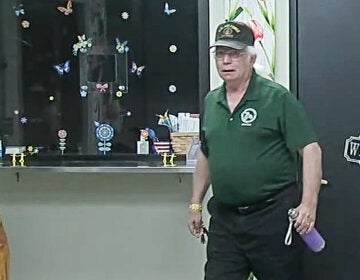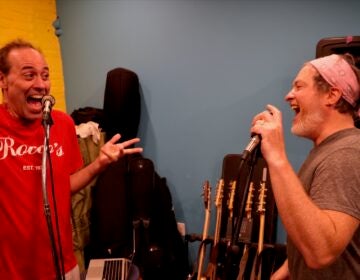Princeton artist asks the big questions: Does God really exist?
The Printmaking Center of New Jersey is in a quaint clapboard building at the crossroads of River Road and Station Road in Branchburg. Blink and you’ll miss it, but enter through the back door and there are surprises inside.
Founded 40 years ago, the center operates the state’s only open printmaking studio. Artists can access the facility all day and into the night, seven days a week. There are classes in everything from papermaking and book arts to lino-cut, collagraphs and hand-set type on the letterpress, taught by leading faculty.
The Printmaking Center – recently renamed from the Printmaking Council of New Jersey – is celebrating its 40th anniversary with an exhibition that honors the incubators who put printmaking on the map in the state. Roots and Rites, on view through Dec. 31, features works on paper by Peter Chapin, one of five New Jersey artists who founded the Printmaking Center, and Judith K. Brodsky, founder and director emeritus, the Brodsky Center for Innovative Editions at Rutgers University, who was also instrumental in the founding of the Printmaking Center. The exhibition title comes from the fact that Chapin and Brodsky planted the seeds for two deeply rooted printmaking institutions in the state.
Director Linda Helm Krapf greets me when I enter the small building and takes me upstairs to the gallery, turning on the lights. Her office, she explains, is inside one of the two gallery rooms. In the larger of the rooms, two niches with windows overlooking the Chambers Brook are used to highlight Chapin’s drypoints, “Perusal” and “Sanctum.”
“Perusal” shows a small figure in a sort of tower with rungs, approaching a planetary body. Around him appear to be ships in a sea, and they flank him just as the two side windows flank the niche – as if this print were made for this setting. Chapin clearly knows the space well. He remained for 14 years after the center’s founding, but has lived in Santa Fe for the past 26 years.
“Sanctum,” another Chapin drypoint, finds sanctuary in the second niche. Whereas the prints by Chapin are serene and meditative, completed with oil pastel, gouache and wax, the prints by Brodsky are not only physically larger but ask the big questions. Krapf explains that Brodsky, situated in the intellectual center of Princeton, is inspired to seek answers to these questions, whereas Chapin is influenced by the peaceful landscapes of New Mexico.
“Half of the works here are etchings and the other half are unique works consisting of digital collages and drawing,” said Brodsky. They’re part of her project, “The Twenty Most Important Questions of the 21st Century,” based on a list she saw in the New York Times a few years ago and that has been on her mind since.
In “How Does the Brain Work,” Brodsky presents us with twin bland faces, covered with a mesh-like grid. In “What Came Before the Big Bang,” we are in the night sky with a black conical shape, suggesting the line of sight from a viewfinder, showing a timeline in billions of years, with quasars at one end and galaxy clusters at the other. In “Why Do We Sleep?” – those as productive as Brodsky, who is also a curator, educator and administrator, must ask that question all the time – we see two eyes surrounded by circular measuring instruments, like something an eye doctor might use, showing “your age in years.” Like the rings on a tree, the numbers of wrinkles around the eye may suggest age – or lack of sleep. Certainly pondering these big questions keeps Brodsky awake.
“Will We Go to Mars?” Brodsky explores this with a sort of space ship, collaged onto a night sky. It appears headed toward the red planet. “Does the Paranormal Exist?” Two identical female heads, one flipped to face the other, wear helmets and headphones, and some kind of measuring device rests on their lower lips.
“Could Science Prove There is a God.” This is, perhaps, the biggest question. Here we see an elliptical shaped planet – Earth? – taking up the whole universe. We are large. We think big. The bigger we think, the bigger we are, the less room there is for a god.
“I’m very conscious of art history,” writes Brodsky. “I know more about past eras through the art of the era than through any other historical records. Artists are impelled by their inner being to make art… I believe that people in the future will learn more about our time through works of art.”
In past decades Brodsky, 80, made work addressing the industrial wasteland, women, family, memory, mortality and science. In this series she is returning to science.
“My choice of content is intuitive, as well as philosophical, and I was struck by the impact of the questions and the fact that they were so visually provocative,” she says. Combining digital processes with mark making, she helps us ponder the unknowable.
Brodsky is working on 10 more questions.
Roots and Rites: Works by Judith Brodsky and Peter Chapin continues at the Printmaking Center of New Jersey, 440 River Road, Branchburg, through Dec. 31.
_________________________________________________________
The Artful Blogger is written by Ilene Dube and offers a look inside the art world of the greater Princeton area. Ilene Dube is an award-winning arts writer and editor, as well as an artist, curator and activist for the arts.
WHYY is your source for fact-based, in-depth journalism and information. As a nonprofit organization, we rely on financial support from readers like you. Please give today.










